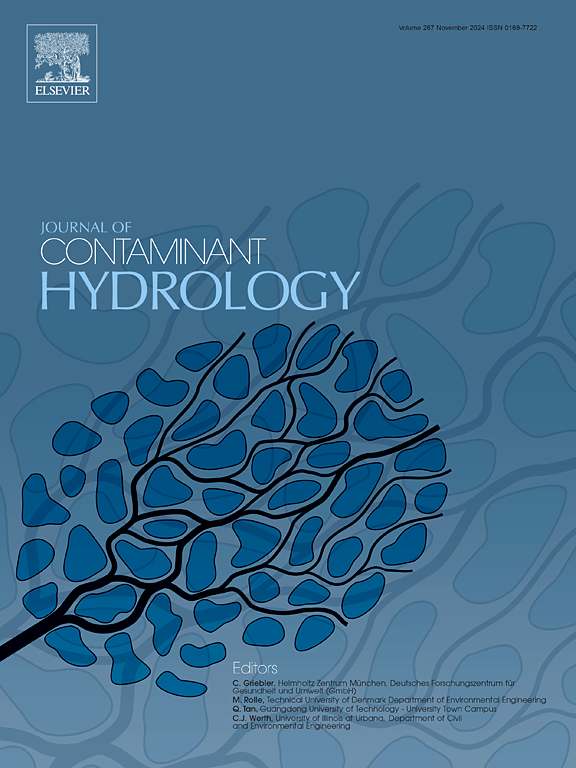Stability and transformation of neptunium (Np) species under geological disposal conditions of high-level radioactive waste (HLW)
IF 4.4
3区 环境科学与生态学
Q2 ENVIRONMENTAL SCIENCES
引用次数: 0
Abstract
Neptunium (Np) is a key radionuclide in high-level radioactive waste (HLW), and its speciation in groundwater directly affects the long-term safety of geological disposal systems. Beishan, Gansu Province, China, is the preferred site for geological disposal of HLWs in China. The weakly alkaline and carbonate-rich groundwater in this region may significantly influence the speciation and migration behavior of Np. This study uses PHREEQC software, incorporating the latest thermodynamic data from NEA-TDB and ThermoChimie databases, to systematically simulate the stability of Np species in deep groundwater of Xinchang in Beishan. It also examines how pH, Eh, temperature, and concentration of major inorganic ligands (e.g., CO₃2−, SO₄2−, F−,) affect Np speciation. The main findings are as follows: (1) Under representative groundwater conditions in Beishan (pH = 8.25), Np primarily exists as KNpO₂CO₃ (92.84 %) and NpO2OH (2.34 %); (2) pH significantly regulates the species transformation of Np. In strongly acidic environments (pH = 2–4), NpF₂2+ and NpF₄ dominate, whereas in weakly alkaline environments (pH = 6–9), KNpO₂CO₃ competes with Np(OH)₄. In highly alkaline environments (pH > 9), Np₂O₅ gradually stabilizes; (3) Changes in oxidation-reduction potential (pe) affect the valence state transformation of Np. Low pe (pe = −5 to −2) favors Np(IV) hydrolysis products, while high pe (pe > 1) stabilizes Np(V) carbonate complexes; (4) Elevated temperatures (30–80 °C) enhance the oxidation and hydrolysis of Np(V), increasing concentrations of Np₂O₅, NpO₂OH, and NpO₂CO₃−; (5) CO₃2− has the most significant effect on Np speciation, while SO₄2−, Cl−, and F− have limited impacts due to their lower chelating abilities or concentrations. The Eh-pH predominance diagram indicates that weakly alkaline, reducing environments are most effective in inhibiting Np migration. This study provides valuable theoretical support for the optimization and long-term safety assessment of the HLW geological disposal site, highlighting the importance of multi-factor coupling in environmental behavior of Np.
高放废物地质处置条件下镎(Np)种类的稳定性和转化。
镎是高放废物中的关键放射性核素,其在地下水中的形态直接影响到地质处置系统的长期安全。中国甘肃省北山是中国高浓缩铀地质处置的首选地点。该地区的弱碱性和富碳酸盐地下水可能显著影响Np的形态和迁移行为。利用PHREEQC软件,结合NEA-TDB和ThermoChimie数据库的最新热力学数据,系统模拟了北山新场深层地下水中Np的稳定性。它还研究了pH, Eh,温度和主要无机配体(例如,CO₃2-,SO₄2-,F-)的浓度如何影响Np的形成。结果表明:(1)在北山代表性地下水条件(pH = 8.25)下,Np主要以KNpO₂CO₃(92.84%)和NpO2OH(2.34%)的形式存在;(2) pH显著调节Np的物种转化。在强酸性环境(pH = 2-4)中,NpF₂2+和NpF₄占主导地位,而在弱碱性环境(pH = 6-9)中,KNpO₂CO₃与Np(OH)₄竞争。在高碱性环境(pH bbbb9)中,Np₂O₅逐渐稳定;(3)氧化还原电位(pe)的变化影响Np的价态转变。低pe (pe = -5 ~ -2)有利于Np(IV)水解产物,而高pe (pe bbb1)有利于Np(V)碳酸盐配合物的稳定;(4)高温(30-80℃)增强了Np(V)的氧化和水解,增加了Np₂O₅、NpO₂OH和NpO₂CO₃-的浓度;(5) CO₃2-对Np的形成有最显著的影响,而SO₄2-、Cl-和F-的影响有限,因为它们的螯合能力或浓度较低。Eh-pH优势图表明,弱碱性、还原性环境对抑制Np迁移最有效。本研究为高放射性废物地质处置场地的优化和长期安全评价提供了有价值的理论支持,突出了多因素耦合在高放射性废物环境行为中的重要性。
本文章由计算机程序翻译,如有差异,请以英文原文为准。
求助全文
约1分钟内获得全文
求助全文
来源期刊

Journal of contaminant hydrology
环境科学-地球科学综合
CiteScore
6.80
自引率
2.80%
发文量
129
审稿时长
68 days
期刊介绍:
The Journal of Contaminant Hydrology is an international journal publishing scientific articles pertaining to the contamination of subsurface water resources. Emphasis is placed on investigations of the physical, chemical, and biological processes influencing the behavior and fate of organic and inorganic contaminants in the unsaturated (vadose) and saturated (groundwater) zones, as well as at groundwater-surface water interfaces. The ecological impacts of contaminants transported both from and to aquifers are of interest. Articles on contamination of surface water only, without a link to groundwater, are out of the scope. Broad latitude is allowed in identifying contaminants of interest, and include legacy and emerging pollutants, nutrients, nanoparticles, pathogenic microorganisms (e.g., bacteria, viruses, protozoa), microplastics, and various constituents associated with energy production (e.g., methane, carbon dioxide, hydrogen sulfide).
The journal''s scope embraces a wide range of topics including: experimental investigations of contaminant sorption, diffusion, transformation, volatilization and transport in the surface and subsurface; characterization of soil and aquifer properties only as they influence contaminant behavior; development and testing of mathematical models of contaminant behaviour; innovative techniques for restoration of contaminated sites; development of new tools or techniques for monitoring the extent of soil and groundwater contamination; transformation of contaminants in the hyporheic zone; effects of contaminants traversing the hyporheic zone on surface water and groundwater ecosystems; subsurface carbon sequestration and/or turnover; and migration of fluids associated with energy production into groundwater.
 求助内容:
求助内容: 应助结果提醒方式:
应助结果提醒方式:


